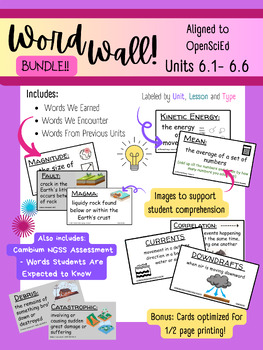Word Wall Vocab - BUNDLE! All 6th grade units in OpenSci Ed!
- Google Slides™

Products in this Bundle (6)
showing 1-5 of 6 products
Description
Looking for a time saver? Want to follow the best practices in OpenSciEd? Make creating your word wall a little easier with these pre-made cards! OpenSciEd resources embrace the best research-based vocabulary practices but for some of my middle school teachers, creating the cards in the moment just wasn’t working with juggling multiple blocks. I created these slides to give them a helping hand. One strategy that hits the best of both worlds is to co-construct the definitions on the whiteboard and then update the slide (or leave it as-is) and post it the following day.
With Google SIides, the cards are fully editable to represent the definitions you co-construct!
This Bundle includes the Word Wall Vocabulary for ALL 6th Grade OpenSciEd Units!
6.1 Light and Matter
6.2 Thermal Energy
6.3 Weather, Climate & Water Cycling
6.4 Plate Tectonics & Rock Cycling
6.5 Natural Hazards
6.6 Cells & Systems
Save money by buying them all together!
Each vocab set includes
- Words We Earned
- Words We Encounter
- Words From Prior Units / Grade Levels
Bonus: We are in CT - and take the NGSS assessment in 5th & 8th so I also included Cambium NGSS Assessment Words Students Are Expected to Know that fit with the OpenSciEd unit.
The cards are optimized for full and 1/2 page printing in color or black and white. I also included high-quality graphics to support comprehension.
As a science instructional coach, I am working closely with all of my 6-8 teachers to implement OpenSciEd. As we learn and grow, so will my slide decks! I will notify you of any additions or improvements we make as we learn together! You can benefit from our work!
I hope they work for you!





